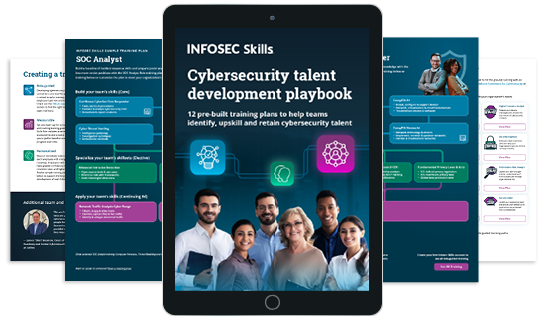What is penetration testing (pentesting), and how does it work? What you need to know
You don't have to imagine a world where hackers can breach your company's defenses, stealing sensitive data and disrupting operations. We live in that world and are constantly reminded of it with news of data breaches. In this world, cybersecurity is a must.
But cybersecurity is more than just using secure passwords, patching applications and using Zero Trust principles. It's hard to know a system is truly secure until it's put to the test. That's why penetration testing is an important component of any cybersecurity strategy. By simulating real-world attacks, penetration testers can identify vulnerabilities and weaknesses before bad actors exploit them.
What should you learn next?

Understanding penetration testing
Penetration testing, or pentesting, is a proactive approach to cybersecurity that involves simulating cyberattacks on a computer system, network or web application to find vulnerabilities that malicious actors could exploit.
There are three main types of penetration testing, and while they may be given different names, they are often called black box, gray box and white box penetration testing:
- Black box: With this type of testing, the pentester does not know the system they are testing.
- White box: In white box testing, testers have complete knowledge of the system they are testing, including its architecture, applications and configurations. This method is often used for internal security assessments.
- Gray box: Gray box testers have some knowledge about a system, but not all. This provides a good balance and simulates real-world scenarios where attackers have gathered some intel about your system.
The penetration testing process
The pentesting process isn't random. It's a methodical process with clearly defined stages to ensure that it's thorough and effective. Here's a breakdown of a typical pen test:
- Planning and reconnaissance: Pentesters work with the business to understand its systems, security goals and what's off-limits during the test. During reconnaissance, they gather information about the target system through public records and other means.
- Scanning and enumeration: Pentesters use scanners to identify vulnerabilities in the system's configuration, software and network.
- Gaining access (exploitation): Using the information they gathered from scanning, the pentesters attempt to exploit the identified vulnerabilities using various techniques to mimic actual attackers.
- Maintaining access (post-exploitation): If they manage to gain access, the pentesters will try to maintain and expand their footprint within the system to determine how much damage a real attacker could do.
- Reporting and remediation: Once testing is complete, the pentesters provide a detailed report outlining the vulnerabilities they found, the exploitability level and the potential impact. Then, they work with the business to prioritize and patch the vulnerabilities.
During the penetration testing process, cybersecurity professionals often follow an established framework for a consistent and comprehensive approach. Three widely recognized standards are:
- Penetration Testing Execution Standard (PTES): This framework outlines the best practice approach for planning, conducting and reporting on pen tests.
- Open Web Application Security Project (OWASP): While not specific to penetration testing, OWASP provides guidance, tools and resources for web application security, including methodologies for web application penetration testing.
- Open Source Security Testing Methodology Manual (OSSTMM): This is a free, community-driven resource offering a comprehensive methodology for security testing.
Tools and techniques in penetration testing
Penetration testers rely on various tools and techniques to identify and exploit vulnerabilities. Here are some of the top pentesting tools they may have in their arsenal:
Commercial tools
- Burp Suite: A comprehensive suite of tools for web application security testing, including vulnerability scanning, penetration testing and compliance reporting.
- Nessus: A commercial vulnerability scanner that identifies and prioritizes network, system and application vulnerabilities.
- Acunetix: A web application security scanner that identifies vulnerabilities, detects malware and provides recommendations for remediation.
Open-source tools
- Nmap: A network scanning and discovery tool that identifies hosts, services and operating systems.
- Metasploit Framework: A popular open-source project for developing, testing and using exploit code.
- Wireshark: A network protocol analyzer that lets you capture and interactively browse for traffic running on a computer network.
Scripting and programming languages
- Python: A popular programming language used in penetration testing for scripting, automation and data analysis.
- PowerShell: A scripting language used in Windows-based penetration testing for automation and exploitation.
Techniques and strategies
- Social engineering: Manipulating people into breaking normal security procedures.
- Phishing: Sending fraudulent emails or messages to trick individuals into revealing sensitive information.
- Password cracking: Attempting to recover passwords from data that has been stored in or transmitted by a computer system.
Pentesters carefully choose tools and techniques based on the specific objectives of the test and the target environment. For example, testing a web application might involve tools like SQL injection scanners and web vulnerability scanners. A network penetration test might use port scanners and packet sniffers to map out the network interface and identify potential weaknesses.
Penetration testing and cybersecurity certifications
Penetration testing skills are highly sought after in cybersecurity; earning relevant certifications can validate your expertise and open doors to many career opportunities. Here are some of the top penetration testing certifications:
-
Certified Ethical Hacker (CEH): This popular certification demonstrates your foundational knowledge of ethical hacking methods and penetration testing tools.
-
CompTIA PenTest+: This certification validates your skills in planning and conducting penetration tests, covering various methodologies and tools.
-
OSCP (Offensive Security Certified Professional): This certification uses a rigorous practical exam to test your hands-on experience.
If you're wondering how to become a penetration tester, earning a certification is a valuable step but not usually the first one. If you don't have experience, you can hone your pentesting skills with open-source tools by participating in online hacking challenges and by practicing in your home lab.
Once you have some experience, penetration testing certification training can help you prepare for the exam more effectively by solidifying your understanding of the concepts tested and allowing you to approach the exam with greater confidence. Mobile and web app penetration testing training is available for those interested in specializing in preparation for the unique vulnerabilities and attack vectors specific to mobile apps and web applications.
What should you learn next?

Role of penetration testing in cybersecurity careers
In 2024, the demand for skilled penetration testers has surged, reflecting these professionals' critical role in shaping cybersecurity strategies. The global penetration testing market is estimated to be valued at $1.7 billion in 2024 and is expected to more than double to $3.9 billion by 2029. This growth is driven by escalating cyber threats, stricter regulations and the rapid adoption of cloud computing and IoT technologies.
As new technologies like these emerge and cyber threats become more advanced, there will be many more penetration testing careers. Penetration testers are at the forefront of cybersecurity, using their skills to find vulnerabilities before they become data breaches. Their work informs the development of robust cybersecurity strategies, ensuring that organizations are prepared to defend against and respond to cyber incidents.
As technologies advance, penetration testing will evolve to keep pace with these new types of cyber threats. Traditional methods will be augmented with innovative techniques to address security challenges posed by digital transformation and the expanding attack surface. Pentesters must continuously update their skills and adapt to new tools and methodologies to provide effective security solutions.
Challenges and ethical considerations in penetration testing
As an ethical hacker, wielding the power to probe a system's defenses comes with great responsibility and some challenges.
At the core of penetration testing lies a strict ethical code. Obtaining proper authorization from the system owner is critical. You wouldn't want someone hacking into your computer without permission. The same principle applies during a pentest. Respecting privacy and data confidentiality is also important. Pentesters should only access and analyze information relevant to the testing scope and avoid any activities that could compromise sensitive data.
There are also legal implications. Penetration testing should always be conducted with written permission and comply with all relevant laws and regulations. This might include data protection laws, privacy regulations and intellectual property considerations.
Penetration testers also constantly face the challenge of staying ahead of the curve. New vulnerabilities emerge all the time, and attackers continuously develop novel exploit techniques. Continuous learning and keeping your skill set up to date with the latest threats and attack vectors will make you successful in this field.
The future of penetration testing
The future of penetration testing holds both exciting possibilities and new challenges. Artificial intelligence (AI) and machine learning (ML) are poised to significantly impact penetration testing just like they've impacted so many other industries. They will help penetration testers:
- Automate testing for more efficiency and less human error
- Enhance detection to identify complex threats and vulnerabilities
- Improve analysis to provide more accurate and actionable insights
The static, one-time penetration test might become a relic of the past, and continuous testing methodologies could be the norm. By integrating automated penetration testing tools into an organization's security infrastructure, vulnerability testing will become ongoing, and response times will be faster.
Despite the potential of AI and ML, the human element will remain crucial in penetration testing. Pentesters' creativity, critical thinking and ability to adapt to unforeseen circumstances will continue to be essential for uncovering complex vulnerabilities and devising effective mitigation strategies.
If you're passionate about cybersecurity, consider developing penetration testing skills. Pursue relevant certifications like the Certified Ethical Hacker (CEH) certification training from EC Council or CompTIA's PenTest+, participate in online pentesting training and hone your practical skills through bug bounty programs. By embracing continuous learning and researching new threats, you can position yourself for a rewarding career in this field.
Learning about penetration testing
Penetration testing is a vital weapon in the cybersecurity arsenal. It offers a proactive approach to identifying and patching vulnerabilities before they can be exploited. By simulating real-world attacks, pentesters play a critical role in safeguarding our digital world.
What are the prerequisites for becoming a penetration tester?
While there's no single path, a strong foundation in computer networking, operating systems and cybersecurity principles is essential. Earning certifications like CEH and PenTest+ and developing hands-on experience through personal projects can significantly enhance your profile and desirability to career recruiters and hiring managers.
How often should organizations conduct penetration testing?
The frequency depends on several factors, including industry regulations, the sensitivity of the data handled and the rate of system changes. A common recommendation is to conduct at least one external penetration test annually, with more frequent testing for high-risk environments.
What should you learn next?

Can penetration testing be automated, and if so, what are the limitations?
Automated tools play a vital role in scanning for vulnerabilities and streamlining repetitive tasks, but they can't fully replace human pentesters. Complex vulnerabilities and social engineering tactics often require the creativity and critical thinking skills that only a human can bring to the table.



